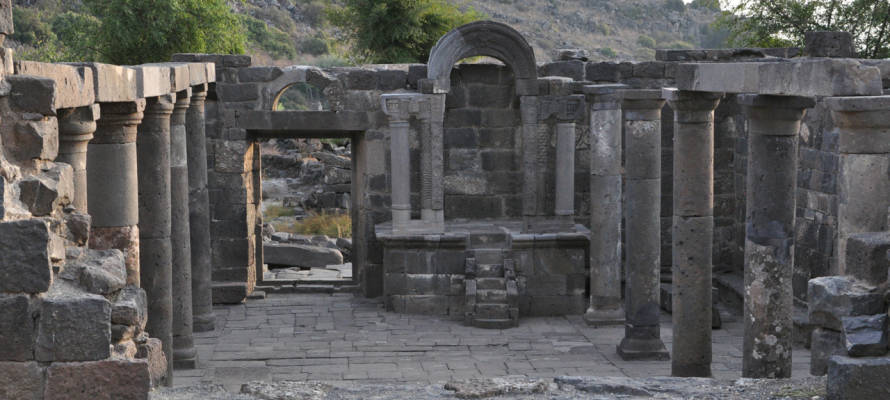One of the most interesting and exciting archaeological projects under way in the Golan Heights is taking place at the synagogue of Umm al Kanatir.
With the destruction of the second Temple in Jerusalem in 70 CE by the Romans, the Jews were on the move. Many were taken by the Romans and transported to far-flung areas of the empire to serve as slaves. Treasures from the Temple were plundered, and according to some theories, many have remained in the Vatican until today.
However, not all Jews were exiled from the Holy Land. Many went north, and communities in the Galilee and the Golan began to take shape and grow. Over the next few centuries, tens of thousands of Jews had reason to head north as the Roman Byzantine persecution of the Jews became more and more intense. Of course, as Jewish communities throughout the Galilee grew, the need for more synagogues also grew. Until the destruction of the Temple, Judaism was, for the most part, a Temple-centered religion, and the use of synagogues was rare. With the destruction of the Temple, the concept of the synagogue as a miniature temple proliferated. The synagogue could not replace the Jerusalem Temple, but it was a focal point of every new Jewish community as well as a visible and physical reminder of the Temple in Jerusalem and our longing to return to it.
Remains of Numerous Synagogues Uncovered
In the Galilee and Golan, archaeologists have uncovered the remains of numerous (more than 60) synagogues from the Roman Byzantine era. Some have withstood the test of time while others have deteriorated. There are a number of common features among them.
The temples of most ancient religions faced eastward, towards the rising sun. In fact, all churches in Israel, except for three, still face east. In Judaism, however, the direction of prayer is meant to be towards Jerusalem, or more accurately, towards the Temple Mount. Hence, the synagogues in the Galilee and Golan face south.
Another common feature is that most had the main entrance on the southern wall, which means that as each person arrived, he or she would have been noticed by the congregation. (Perhaps this was a good way of assuring that no one came late for the services! Maybe we should try this today…) Other common elements include the layout of the building, windows and arches and the use of mosaic floors.
Our understanding of this period relies heavily on various ruins and from any writings dating back to this era. Piecing them together – writings and archaeological ruins – gives us a snapshot of synagogues during the Roman Byzantine era.
One of the most interesting and exciting archaeological projects underway in the Golan Heights is the synagogue of Umm al Kanatir, or “Mother of Arches.” Its name is derived from an arch uncovered nearby. We do not know the actual ancient name of the town. Umm al Kanatir is an out-of-the-way place that was destroyed by an earthquake in the year 749 CE. What makes Umm al Kanatir unique is that after the earthquake, the collapsed basalt stones of the synagogue were not plundered nor taken to be used for other projects. Essentially, all the stones of the synagogue were just sitting on the ground, waiting to be pieced back together.
In 2003 archaeologists launched an effort to restore the synagogue as much as possible to its original form. Those involved in the project began by evaluating all the various stones found on site in order to create a 3-D image of the building. Then, using computer simulations, they “collapsed” the building in an earthquake so that they could reasonably assume where the pieces would have fallen. With the aid of high-tech computer technology, they tagged the actual stones with computer chips. Using specially designed cranes, they began the actual reconstruction, with the goal being a full reassembly.
Since the establishment of the modern State of Israel in 1948, our enemies have done all they can to deny our religious and historic connection to the land. The synagogue at Umm al Kanatir is another stone in the puzzle of Jewish history, shouting out loud the eternal connection of the Jewish people to the land.
By Rabbi Moshe Rothchild
Licensed Tour Guide

Free Ebook: 10 Best Places to Visit in Israel
The Land of Israel has provided the backdrop for some of the most important events in human history. From the Old City in Jerusalem to the Sea of Galilee, people from all over the globe visit the Holy Land each year to take in the breathtaking scenery and inspiration of Israel. Now you can experience this beauty for yourself from the comforts of home and maybe plan a trip of your own to Israel. Get the free, exclusive eBook from United with Israel: The 10 Best Places to Visit in Israel.
